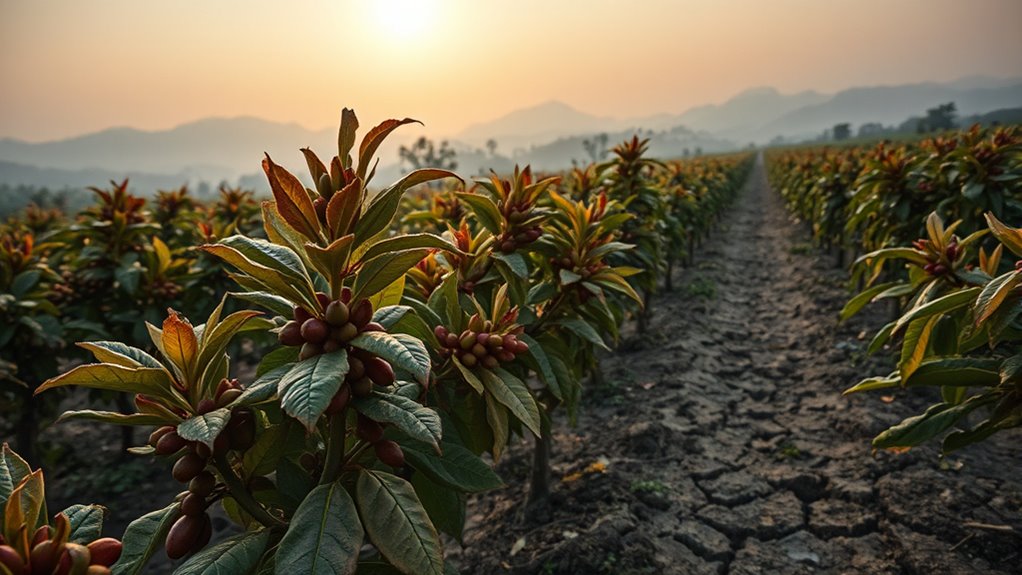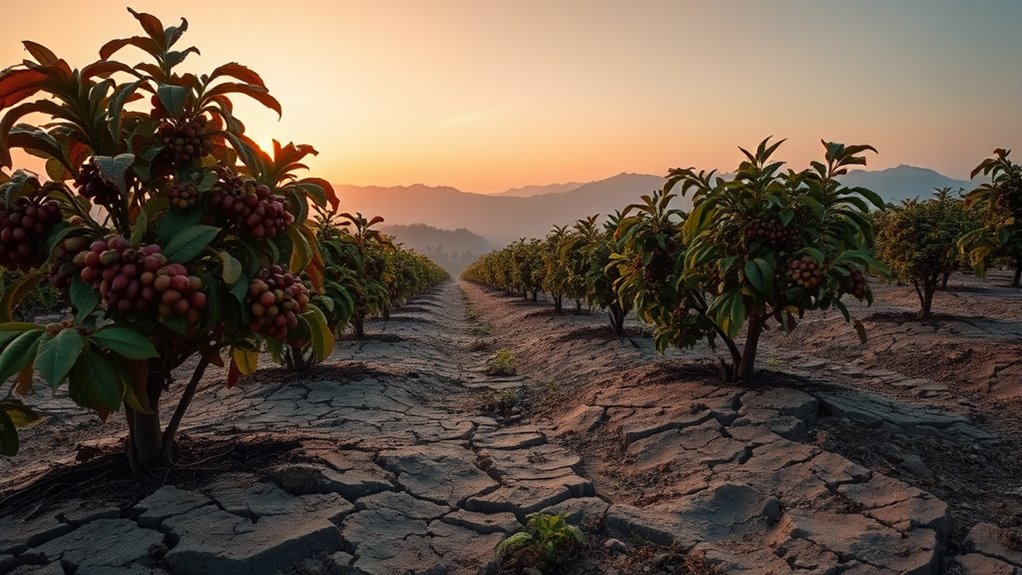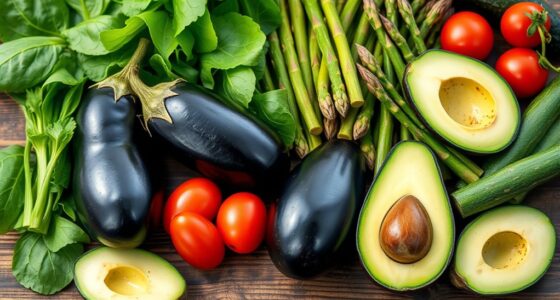Climate change is impacting your coffee by raising temperatures that push plants out of their ideal zones, causing slower growth and lower yields. Changes in rainfall lead to droughts or floods, disrupting harvesting and damaging crops. Warmer, wetter conditions also increase pests and diseases like coffee rust and beetles, threatening quality. Moving farms isn’t always feasible, so producers must adapt with new varieties or practices. To discover more about how these shifts affect your coffee, keep exploring this topic.
Key Takeaways
- Rising temperatures stress coffee plants, reducing growth, bean quality, and overall yields.
- Higher altitudes are needed for cultivation, but suitable land is limited and often impractical to access.
- Altered rainfall patterns cause droughts or floods, disrupting planting, harvesting, and crop development.
- Warmer, wetter conditions increase pest and disease prevalence, threatening plant health and farmer livelihoods.
- Climate-induced changes in bean chemistry affect flavor profiles, challenging industry consistency and adaptation efforts.

Have you ever wondered how rising global temperatures are affecting your daily cup of coffee? The truth is, climate change is transforming coffee production in ways that directly impact the flavor, availability, and even the very plants that produce your favorite brew.
As temperatures climb, coffee-growing regions face a host of challenges, from shifting rainfall patterns to increased pest and disease pressures. These changes threaten the delicate balance that coffee plants need to thrive, making it harder to produce high-quality beans consistently.
In many traditional coffee-growing areas, such as Central America, Africa, and Southeast Asia, higher temperatures push coffee plants out of their ideal growing zones. Coffee plants, especially Arabica, are sensitive to temperature fluctuations and thrive within a narrow range. When temperatures rise above this range, plants experience stress, which can stunt growth, reduce yields, and diminish bean quality.
This means farmers may need to move their plantations to higher altitudes, but suitable land at these elevations is limited, and relocating isn’t always feasible or sustainable. As a result, the overall supply of coffee becomes more unpredictable, risking shortages and price hikes that ripple through the global market.
Rainfall patterns are also shifting, causing droughts or floods that further harm coffee crops. Insufficient water can weaken plants and reduce bean size, while excessive rain can lead to root diseases and mold. These weather extremes make it difficult for farmers to plan their planting and harvesting schedules, leading to inconsistent crop yields year after year.
Furthermore, the warmer and wetter conditions foster the proliferation of pests like coffee borer beetles and diseases such as coffee rust. These pests and illnesses thrive in altered climates, and their increased prevalence means farmers must invest more in pest control and disease management, raising production costs and threatening the livelihoods of smallholder farmers.
The impact isn’t just on quantity but also on the quality of coffee beans. Fluctuations in temperature and moisture levels can change the chemical composition of the beans, ultimately affecting flavor profiles. This makes it harder for roasters and consumers to enjoy consistent, high-quality coffee.
Additionally, climate change-induced stress can make coffee plants more susceptible to pests and diseases, creating a compounding challenge for growers. As climate change accelerates, the regions that once produced renowned coffees may no longer be suitable, forcing the industry to adapt by exploring new varieties or shifting production zones. For you, this could mean a future where your favorite coffee comes from unexpected places or tastes subtly different, reflecting the complex effects of a changing climate on this cherished beverage.
Frequently Asked Questions
How Are Coffee Farmers Adapting to Changing Climate Conditions?
You might notice coffee farmers are adapting by switching to more resilient coffee varieties that withstand extreme weather. They also implement sustainable practices like shade-grown coffee, adjusting planting times, and investing in better irrigation systems.
Some farmers explore alternative crops, while others participate in research to develop climate-resistant coffee plants. These strategies help them cope with changing conditions, ensuring their livelihoods and maintaining coffee supply for consumers like you.
What New Coffee Varieties Are Resistant to Climate Change?
Imagine discovering new coffee varieties that could save your farm from climate chaos. Researchers are developing resilient strains like Catimor and Geisha, engineered to withstand rising temperatures and unpredictable weather. These varieties aren’t just innovations; they’re lifelines.
If you adopt them, you could preserve your harvests and future-proof your livelihood. The question isn’t just about resistance—it’s about securing a sustainable coffee future amidst an uncertain climate.
How Does Climate Change Affect Coffee Bean Quality?
You might notice that climate change affects coffee bean quality by causing fluctuations in temperature and rainfall. These changes stress coffee plants, leading to inconsistent bean development and flavor profiles.
Warmer temperatures can accelerate ripening, reducing flavor complexity, while irregular weather can increase disease susceptibility. As a result, you’ll find that the overall quality and taste of your coffee become less predictable, impacting your enjoyment and the sustainability of coffee farming.
What Are the Economic Impacts of Climate Change on Coffee Exports?
Imagine your favorite coffee as a steady ship sailing towards prosperity. Climate change acts like turbulent storms, disrupting trade routes and causing unpredictable harvests.
You’ll face economic losses as exports decline, prices fluctuate, and farmers struggle to adapt. This instability threatens your coffee supply chain, making it harder to maintain quality and affordability.
Ultimately, climate change jeopardizes the economic health of coffee-exporting nations and your daily coffee experience.
Are There Sustainable Practices to Mitigate Climate Effects on Coffee Farming?
You can adopt sustainable practices like shade-grown coffee to reduce heat stress and preserve biodiversity. Implementing water-efficient irrigation helps conserve resources, while crop diversification minimizes risks from climate variability.
Using organic fertilizers improves soil health, and adopting resilient coffee varieties boosts your farm’s adaptability. These strategies not only help mitigate climate effects but also promote long-term productivity, ensuring your coffee farming remains viable despite changing environmental conditions.
Conclusion
As the planet’s climate shifts like an unpredictable tide, coffee plantations face a storm of challenges. Your morning brew, once reliable, now teeters on the edge of uncertainty, threatened by rising temperatures and changing rain patterns. But with awareness and action, you can be part of the ripple effect, helping to protect these precious beans. Together, we can nurture hope and safeguard coffee’s future, ensuring that every cup continues to warm hearts and energize mornings for generations to come.









